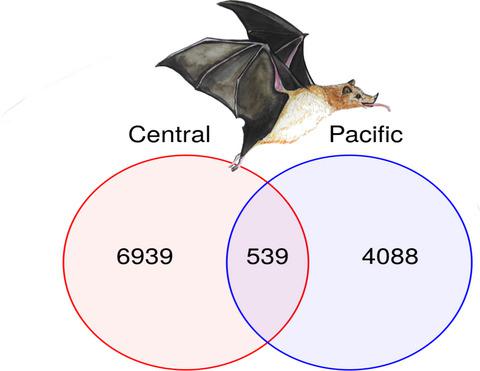当前位置:
X-MOL 学术
›
Microbiologyopen
›
论文详情
Our official English website, www.x-mol.net, welcomes your feedback! (Note: you will need to create a separate account there.)
Geographical separation and physiology drive differentiation of microbial communities of two discrete populations of the bat Leptonycteris yerbabuenae.
MicrobiologyOpen ( IF 3.4 ) Pub Date : 2020-03-17 , DOI: 10.1002/mbo3.1022 Osiris Gaona 1, 2 , Daniel Cerqueda-García 3 , Andrés Moya 4 , Ximena Neri-Barrios 2 , Luisa I Falcón 2
MicrobiologyOpen ( IF 3.4 ) Pub Date : 2020-03-17 , DOI: 10.1002/mbo3.1022 Osiris Gaona 1, 2 , Daniel Cerqueda-García 3 , Andrés Moya 4 , Ximena Neri-Barrios 2 , Luisa I Falcón 2
Affiliation

|
In this paper, we explore how two discrete and geographically separated populations of the lesser long‐nosed bat (Leptonycteris yerbabuenae)—one in central and the other in the Pacific region of Mexico—differ in their fecal microbiota composition. Considering the microbiota–host as a unity, in which extrinsic (as food availability and geography) or intrinsic factors (as physiology) play an important role in the microbiota composition, we would expect differentiation in the microbiota of two geographically separated populations. The Amplicon Sequences Variants (ASVs) of the V4 region of the 16s rRNA gene from 68 individuals were analyzed using alpha and beta diversity metrics. We obtained a total of 11 566 (ASVs). The bacterial communities in the Central and Pacific populations had a diversity of 6,939 and 4,088 ASVs, respectively, sharing a core microbiota of 539 ASVs accounting for 75% of the relative abundance, suggesting stability over evolutionary time. The Weighted UniFrac metrics tested by a PERMANOVA showed that lactating and pregnant females had significant beta diversity differences in the two populations compared with other reproductive stages. This could be a consequence of the increased energy requirements of these physiological stages, more than the variation due to geographical separation. In contrast, a positive correlation of the observed ASVs of fecal microbiota with the observed ASVs of plastids related to the diet was observed in the juveniles and adults, suggesting that in these physiological stages an extrinsic factor as the diet shapes the microbiota composition. The results provide a baseline for future studies of the microbiome in these two wild populations of the lesser long‐nosed bat, the main pollinator of the Agaves from which the beverages tequila and mezcal are made.
中文翻译:

地理分离和生理学驱动了蝙蝠 Leptonycteris yerbabuenae 两个离散种群的微生物群落的分化。
在本文中,我们探讨了两个离散且地理上分离的小长鼻蝙蝠(Leptonycteris yerbabuenae)种群(一个位于墨西哥中部,另一个位于墨西哥太平洋地区)的粪便微生物群组成有何不同。考虑到微生物群-宿主是一个整体,其中外在因素(如食物供应和地理位置)或内在因素(如生理学)在微生物群组成中发挥着重要作用,我们预计两个地理上分离的种群的微生物群会存在差异。使用 α 和 β 多样性指标分析了 68 名个体 16s rRNA 基因 V4 区的扩增子序列变异体 (ASV)。我们总共获得了 11 566 个(ASV)。中部和太平洋种群的细菌群落多样性分别为 6,939 个和 4,088 个 ASV,共享 539 个 ASV 的核心微生物群,占相对丰度的 75%,这表明在进化过程中具有稳定性。PERMANOVA 测试的加权 UniFrac 指标显示,与其他生殖阶段相比,哺乳期和怀孕女性在这两个群体中存在显着的 β 多样性差异。这可能是这些生理阶段能量需求增加的结果,而不是地理分离造成的变化。相比之下,在青少年和成体中观察到的粪便微生物群的 ASV 与与饮食相关的质体的 ASV 呈正相关,这表明在这些生理阶段,饮食塑造微生物群组成时存在外在因素。这些结果为未来研究小长鼻蝙蝠这两个野生种群的微生物组提供了基线,小长鼻蝙蝠是龙舌兰的主要传粉者,龙舌兰酒和梅斯卡尔饮料就是由龙舌兰制成的。
更新日期:2020-03-17
中文翻译:

地理分离和生理学驱动了蝙蝠 Leptonycteris yerbabuenae 两个离散种群的微生物群落的分化。
在本文中,我们探讨了两个离散且地理上分离的小长鼻蝙蝠(Leptonycteris yerbabuenae)种群(一个位于墨西哥中部,另一个位于墨西哥太平洋地区)的粪便微生物群组成有何不同。考虑到微生物群-宿主是一个整体,其中外在因素(如食物供应和地理位置)或内在因素(如生理学)在微生物群组成中发挥着重要作用,我们预计两个地理上分离的种群的微生物群会存在差异。使用 α 和 β 多样性指标分析了 68 名个体 16s rRNA 基因 V4 区的扩增子序列变异体 (ASV)。我们总共获得了 11 566 个(ASV)。中部和太平洋种群的细菌群落多样性分别为 6,939 个和 4,088 个 ASV,共享 539 个 ASV 的核心微生物群,占相对丰度的 75%,这表明在进化过程中具有稳定性。PERMANOVA 测试的加权 UniFrac 指标显示,与其他生殖阶段相比,哺乳期和怀孕女性在这两个群体中存在显着的 β 多样性差异。这可能是这些生理阶段能量需求增加的结果,而不是地理分离造成的变化。相比之下,在青少年和成体中观察到的粪便微生物群的 ASV 与与饮食相关的质体的 ASV 呈正相关,这表明在这些生理阶段,饮食塑造微生物群组成时存在外在因素。这些结果为未来研究小长鼻蝙蝠这两个野生种群的微生物组提供了基线,小长鼻蝙蝠是龙舌兰的主要传粉者,龙舌兰酒和梅斯卡尔饮料就是由龙舌兰制成的。



























 京公网安备 11010802027423号
京公网安备 11010802027423号